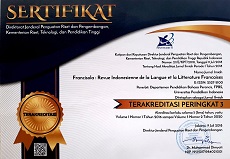LA MULTIPLICATION DES PERSPECTIVES AU PROFIT DE L’EXPRESSIVITÉ: UNE ÉTUDE DU ROMAN LES SIGNES PARMI NOUS DE C.F. RAMUZ
Abstract
RÉSUMÉ. Nous analyserons l’incertitude des voix et la création idiosyncratique des subjectivités provisoires dans le discours narratif chez Ramuz. L’analyse portera sur les diverses modalités liées au décentrement du discours narratif : la désorganisation des temps verbaux, l’emploi du pronom « on », du discours indirect libre ainsi que l’intertexte biblique. Nous étudierons également la notion de perception chez Ramuz. La simultanéité des perceptions contribuant au problème de détermination de la voix narrative met en relief l’exotopie de l’auteur par rapport aux personnages, ce qui relève du besoin inhérent de donner aux personnages leur propres voix. La multiplication des points de vue crée une collectivité de perspectives. Cette collectivité devient la conscience globale du texte qui s’achève avec l’interprétation du lecteur. Le rôle fondamental du lecteur se trouve ainsi souligné.
Mots-clés: conscience, intertextualité, perceptions, pluralité, voix.
ABSTRACT. We will analyze the uncertainty of the voices and the idiosyncratic creation of provisonal subjectivities in the narrative discourse of Ramuz. The analysis will deal with the different modalities linked with the decentralisation of the narrative discourse : disorganisation of verb tenses, the use of the pronoun « on », free indirect speech as well as biblical intertext. We will also study the notion of perception in Ramuz’s work. The simultaneous nature of the perceptions contributes to the problem of determination of the narrative voices that highlights the exotopy of the author vis-a-vis the characters, which indicates the inherent need of giving the characters their individual voices. The multiplication of the points of view creates a collectivity of perspectives. This collectivity becomes the global conscience of the text that is achieved with the interpretation of the reader. The fundamental role of the reader thus needs to be highlighted.
Keywords: conscience, intertextuality, perceptions, plurality, voices.
Full Text:
PDFReferences
Bakhtine, M. (1978). Esthétique et théorie du roman. Paris : Gallimard.
Barthes, R. (1982). Littérature et réalité. Paris : Editions de Seuil.
Bres, J. et Nowakowska, A. (2007). Voix, point de vue…ou comment pêcher le dialogisme à la métaphore. Cahier de praxématique, 49, 103-132. doi : 10.4000/praxematique.937.
Froidevaux, G. (1982). L’Art et la Vie, L’Ésthétique de C.F Ramuz entre le Symbolisme et les avant-gardes. Lausanne : L’Age d’Homme.
Kila, N. (2013). Dynamismes et structures de la perception dans l’œuvre de Charles Ferdinand Ramuz (Thèse de doctorat, Université d’Artois, France). Repéré à http://irodalomdoktori.btk.pte.hu/files/tiny_mce/dolgozat.KILA.No%C3%A9mi.pdf.
Kristeva, J. (1969). Sémiotikè, recherches pour une sémanalyse. Paris : Seuil.
Magureanu, A. (2014). Dialogisme, polyphonie et intertextualité dans le dialogue romanesque. Editura Academiei RRL, 3, 247-258.
Mahrer, R. (2006). Un français de plein air : la langue romanesque de C. F. Ramuz. Le français moderne, 2, 219-235.
Mahrer, R. et Wiser, A. (2007). La notion de temporalité phénoménologique chez C.F. Ramuz (Présence de la mort, 1919) et Claude Simon (La Bataille de Pharsale, 1969). Paris : Harmattan.
Nølke, H. et Fløttum, K. N. (2004). ScaPoLine – La théorie scandinave de la polyphonie linguistique. Paris : Editions Kimé.
Ramuz, C.F. (1967). Raison d’Être, Œuvres complètes 7. Lausanne : Éditions Rencontre.
Ramuz, C.F. (1970). Découverte du monde, Lausanne : Plaisir de Lire.
Ramuz, C.F. (2005). Les Signes Parmi Nous, Romans, tome 1, Bibl. de la Pléiade. Paris : Gallimard.
Stolz, C. (2015) Polyphonie et intertextualité. Repéré à www.fabula.org.
DOI: https://doi.org/10.17509/francisola.v1i1.2561
Refbacks
- There are currently no refbacks.
Copyright (c) 2016 FRANCISOLA
View My Stats










